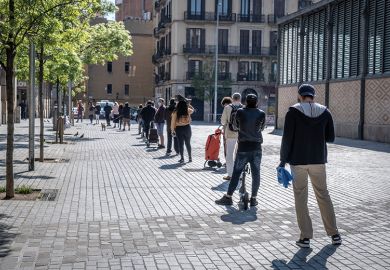First-year students are set to be a priority across Europe when campuses tentatively reopen in the autumn, to avoid an increase in dropout rates − but low reliance on tuition fees means there is less pressure to restart in-person teaching for some continental institutions.
There is a patchwork of different approaches across the continent. German universities do not expect physical lectures to resume until 2021, but some countries, such as Denmark, hope to open almost as normal come the new academic year.
Dutch universities have been among the most proactive in reassuring prospective students: “Dutch universities are open,” the Association of Universities in the Netherlands stressed earlier this month.
As face-to-face contact and other campus activities resume, first-year students and lab work will be prioritised, explained Robert-Jan Smits, president of Eindhoven University of Technology.
“The priority will not be partying, of course,” he said, and lectures will remain online “most likely” until the end of the year. But, he stressed, “We would like small groups of new students to get a feel of both the university and the city where they are studying.”
In June, universities will launch a “massive” campaign “to make it clear that we will offer not just online” courses next year, he said.
In reopening, European universities are freer to remain cautious and to be honest with prospective students because they are far less dependent on tuition fees, some institutional leaders told Times Higher Education.
“We will not go as far as certain US universities,” said Professor Smits. He said he had been “shocked” by some US institutions for “giving the impression” that student life would be “safe and normal” come the autumn, because they “needed the cash”.
At the Sorbonne University, “we don’t depend on these students [financially]”, said Marie-Céline Daniel, the institution’s vice-president of education and lifelong learning. “The responsibility we have is to be candid that their experience of Paris from September onwards is going to be disappointing” because of ongoing restrictions introduced to fight the spread of the coronavirus, she added.
On 20 May, Dutch institutions agreed a reopening plan with the government to allow “small scale” physical education again from mid-June. To avoid a crush of students on rush-hour public transport, campus education will, for now at least, be allowed only between 11am and 3pm and after 8pm.
Staggering campus opening hours to avoid the rush hour has also been mooted in France, said Professor Daniel.
The French government currently wants physical distancing on campus – meaning four square metres per student in a room – to continue in the autumn, she added.
“We don’t have that many rooms,” Professor Daniel explained. As a result, big lectures will likely stay online, and students might have to be rotated on to campus for face-to-face group work, perhaps a third at a time.
In such a rota system, first-year students would get priority on campus, she said. “We want them to be autonomous, but we know they are not autonomous when they come into university,” Professor Daniel said. The risk is that a lack of physical contact stunts their social life and education, she said, leading to dropouts later on.
In Sweden, “the first-year students, the welcoming part, is one of the priorities”, said Marita Hilliges, secretary general of the Association of Swedish Higher Education Institutions. If new students do not settle in socially, this could lead to a higher dropout rate later, she warned: “It could be harder for them to find their way.”
In Denmark, universities “are hoping to return to business as usual at the beginning of autumn”, except for big gatherings and overnight activities traditionally put on to welcome first-year students, explained Jesper Langergaard, director of Universities Denmark.
Still, there are plans to spread students out in lecture halls, meaning large classes might have to take place at least partially online, said Jasper Winkel, head of communications at the University of Copenhagen.
At the more cautious end of the scale are German universities, where lectures are expected to remain online and physical teaching to be restricted to hands-on training, until at least spring 2021, said Peter-André Alt, president of the German Rectors’ Association.
“It’s somewhat looking into a crystal ball,” he said, but “if you want to avoid infections, you need to avoid mass meetings”. However, labs and libraries are beginning to reopen, he added.
POSTSCRIPT:
Print headline: Europe eyes restart with first-years placed first
Register to continue
Why register?
- Registration is free and only takes a moment
- Once registered, you can read 3 articles a month
- Sign up for our newsletter
Subscribe
Or subscribe for unlimited access to:
- Unlimited access to news, views, insights & reviews
- Digital editions
- Digital access to THE’s university and college rankings analysis
Already registered or a current subscriber?







